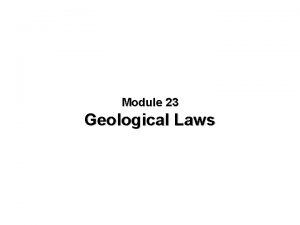Department of Geology and Geological Engineering Van Tuyl

- Slides: 1

Department of Geology and Geological Engineering Van Tuyl Lecture Series- Fall 2015 4: 00 -5: 00 p. m. in Berthoud Hall Room 241 Thursday, September 24, 2015 Bruce Trudgill Colorado School of Mines Geology and Geological Engineering Department “Utah's Belly Button: Unraveling the Origin of Upheaval Dome and the Importance of Field Observations in the Scientific Process” Abstract: Bruce Trudgill 1 Pat Geesaman 2, Thomas Hearon 3, Mark G. Rowan 4 1. Geology & GE, Colorado School of Mines, Golden, CO, United States. 2. Anadarko Petroleum Corporation, Houston, TX, United States. 3. Structure and Geomechanics, Geological Technology, Conoco. Phillips Company, Houston, TX, United States. 4. Rowan Consulting, Inc. , Boulder, CO, United States. The origin of Upheaval Dome is a long-argued debate in the geology of SE Utah, and highlights a number of issues relating to selective data manipulation to support a particular hypothesis. The present-day feature is an eroded structural dome that exposes Mesozoic strata along with associated folds, faults and sand injectites in the Paradox basin, SE Utah. Multiple interpretations for its origin have been proposed, but the two remaining viable hypotheses are at opposite ends of the geologic spectrum: one proposing long-term salt-related deformation and growth of the structure, the other a catastrophic meteorite impact. Analysis of field data collected in Triassic to Jurassic-aged strata adjacent to Upheaval Dome reveals: (1) stratigraphic thicknesses from measured sections for the Kayenta Formation (~199 to ~195 Ma) that range from 7 meters to 224 meters, and projected thicknesses in cross section that can exceed 400 meters; (2) distinct changes in facies distributions in relation to mapped structures; (3) localized angular unconformities and stratal-onlap surfaces; (4) synclinal growth axes and associated depositional centers shift away from the center of the dome throughout the Late Triassic/Early Jurassic; (5) stratigraphic thicknesses increase across normal faults on the scale of meters to tens of meters. These structural features and associated growth strata offer compelling evidence for long-term deformation compatible with salt tectonics at Upheaval Dome during the Late Triassic/Early Jurassic. Sparse indicators of catastrophic impact are present in the Kayenta Formation in the form of two shocked quartz grains, orders of magnitude less than would be expected <1 km from a meteorite impact site. We interpret these grains to be detrital and sourced from outside the Paradox basin. In our interpretation of salt-related deformation, we discuss the merits and drawbacks of a model invoking collapse over a buried salt high to a prior model of a pinched-off diapiric feeder to an eroded salt glacier. The possibility that a meteorite impact of Late Permian to Early Triassic age initiated the growth of an isolated salt pillow in the western part of the northern Paradox Basin requires further investigation.

